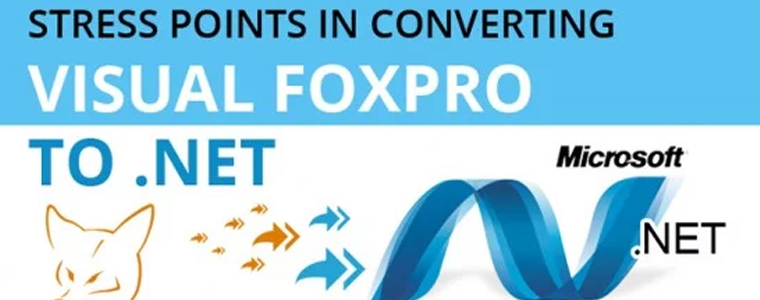
By Imran Salahuddin | February 26th, 2021 |
As far as an application developer is concerned, migrating Visual FoxPro (VFP) to the .NET platform is the opening of a brand-new world of possibilities.
One of the benefits of converting VFP to .NET is that .NET is not just a single language but a group of co-related development technologies that supports a wide range of functionalities. Microsoft announced the end of life for VFP and has come up with a top-notch advanced .NET platform that allows developers to easily implement complex functionalities with a visually appealing user interface.
So, what are the critical aspects that are to be taken care of for .NET migration? Migration task needs to be handled with a clear plan of action. Below listed are some of the points that must be considered, while performing a VFP to .NET migration effort.
VFP uses a native database and .Net uses SQL server, while they are both databases in functionality they are worlds apart. The biggest issue when it comes to migration is the changing the database. This is often completed even before the application migration is started, as the database contains all the data and saved information which will be needed moving forward. Databases are also scaled up for future requirements.
Visual FoxPro is a language which leans heavily on frameworks; thus, the programs do not need ActiveX controls or COM objects. The lack of individual components make VFP programs fast and snappy. The essential part is that if the migration needs a .Net framework such as Macrosoft’s proprietary Dazzle, it needs to be integrated right in the beginning of the migration.
The first step in a migration effort is documenting the existing VFP application specifications. Start by preparing a chart of control architecture, variable declaration, and then commands. Next a set of tables will be created with data and data types, define the relationships between these data tables. The conversion directly depends on the size of the already existing application, such as the number of forms, reports, and programs associated. By taking these values on account, the timespan of conversion can be determined. Business rules are to be considered as well.
For executing an application migration process, a detailed outline needs to be created. Add-on benefits that come up with migration need to be considered in this phase. As VFP was built mainly to support desktop-based applications, .NET brings the added benefit of leveraging the power of the web. Also, it should be noted that .NET scales well to larger-sized applications. The best way to approach the migration process is to logically divide the application into different segments and concentrate on each section migration.
Migrating the individual data files from VFP to SQL server or any other DBMS should be performed carefully. If the existing VFP application does have SQL back-end support, this process can be avoided. The immediate step is to optimize the existing data. The next step is making the program compatible with the SQL server or the migrated database.
The application will be developed in different stages to ensure a smooth transition. The development phase is followed by testing and then corrections as required. The migration effort ends with the creation of applicable supporting documents such as user guides and manuals.
In the migration process, the testing and quality control starts from day one, from the first line of code to the last line of code, every new line is checked for quality on the day it is written. Unlike in a new project development, the outputs need to match the existing functionalities.
For more information related to .NET migration services, contact us.